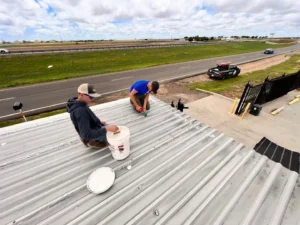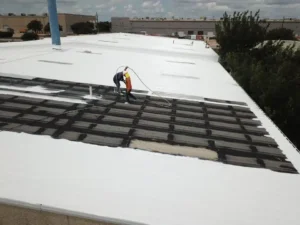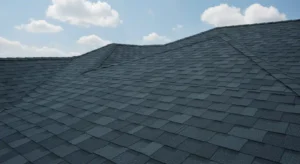Introduction
Metal roofs are known for their durability, but exposure to weather, temperature fluctuations, and environmental pollutants can lead to wear over time. Restoration helps extend the life of a metal roof without the need for a costly replacement. By addressing minor issues early, property owners can protect their investment and maintain energy efficiency.
Understanding Metal Roof Deterioration
Metal roofing systems experience various forms of degradation, including rust, leaks, and coating breakdown. These issues arise due to factors such as prolonged UV exposure, water accumulation, and physical damage from wind or debris. Without timely intervention, small problems can escalate, leading to structural concerns and increased repair costs.
Common Causes of Wear and Tear
- Rust and Corrosion: Exposure to moisture and oxygen can cause oxidation, weakening the metal surface.
- Thermal Expansion and Contraction: Temperature fluctuations cause metal panels to expand and contract, which can loosen fasteners and create gaps.
- Water Penetration: Standing water from poor drainage can seep into seams and fasteners, accelerating deterioration.
- Coating Degradation: Over time, protective coatings wear down, leaving the metal vulnerable to the elements.
Key Steps in Metal Roof Restoration
Restoring a metal roof involves several steps that target structural integrity and weather resistance. These steps not only improve performance but also enhance energy efficiency by reflecting heat away from the building.
1. Inspection and Assessment
A thorough inspection identifies existing damage, rust spots, loose fasteners, and leaks. Professional roofers use moisture detection tools and visual checks to determine the extent of wear and tear.
2. Cleaning the Roof Surface
Before applying any restoration materials, the roof must be cleaned. Pressure washing removes dirt, debris, mold, and old coatings. This step ensures better adhesion for sealants and coatings.
3. Rust Treatment and Primer Application
Rust-prone areas are treated with rust inhibitors to prevent further oxidation. A corrosion-resistant primer is then applied to strengthen adhesion and extend the life of the topcoat.
4. Sealing Seams and Fasteners
Loose or missing fasteners are replaced, and seams are reinforced with high-quality sealants. This prevents leaks and minimizes movement caused by thermal expansion.
5. Applying Reflective Roof Coatings
Reflective roof coatings provide an additional layer of protection against UV damage and moisture. These coatings help regulate temperature, reducing cooling costs and preventing premature wear.
Benefits of Metal Roof Restoration
Restoring a metal roof offers multiple advantages, making it a practical alternative to full replacement.
Cost Savings
Restoration is significantly more affordable than replacing an entire roof. It minimizes labor and material costs while extending the roof’s lifespan by 10-20 years.
Energy Efficiency
Reflective coatings help reduce heat absorption, keeping indoor spaces cooler. This translates to lower energy bills and improved indoor comfort.
Environmental Impact
Roof restoration reduces waste by preserving existing materials. It also minimizes the demand for new roofing materials, lowering the environmental footprint of a building.
Minimal Disruption
Unlike full roof replacements that require extensive labor and downtime, restoration is a faster process with less inconvenience to building occupants.
Choosing the Right Restoration Method
Different restoration methods suit different types of metal roofs. The right approach depends on the roof’s condition, climate, and budget.
Acrylic Coatings
Acrylic-based coatings offer excellent UV resistance and flexibility. They are ideal for moderate climates where temperature swings are not extreme.
Silicone Coatings
Silicone coatings provide superior waterproofing and are best suited for areas with heavy rainfall or high humidity.
Polyurethane Coatings
These coatings offer enhanced impact resistance and durability, making them suitable for industrial settings or high-traffic areas.
Professional vs. DIY Restoration
While minor maintenance can be handled by property owners, professional restoration ensures long-lasting results. Roofing specialists have the expertise, equipment, and materials to perform high-quality restorations that comply with safety and warranty requirements.
Signs You Need Professional Help
- Persistent leaks despite patching
- Visible rust or peeling coatings
- Loose or missing fasteners
- Large areas of pooling water
- Increased energy costs due to poor insulation
Protect Your Investment
Regular maintenance and timely restoration keep a metal roof in optimal condition. Ignoring early signs of deterioration can lead to costly repairs or premature replacement. If your metal roof shows signs of wear, consider a professional inspection and restoration to maximize its performance and longevity.
For expert metal roof restoration services, contact Flatland Roofing & Insulation at (806) 606-6794 or email info@flatlandroofcoatings.com. Our team specializes in high-quality restoration solutions that extend the life of your metal roof while improving energy efficiency.
Frequently Asked Questions (FAQs)
1. How long does a metal roof restoration last?
A properly restored metal roof can last 10-20 years, depending on the materials used and environmental conditions.
2. Is restoration cheaper than replacing a metal roof?
Yes, restoration costs significantly less than a full replacement while offering similar benefits in terms of protection and longevity.
3. What is the best coating for metal roof restoration?
The best coating depends on the climate and specific needs. Acrylic coatings work well in moderate climates, while silicone coatings are ideal for wet environments.
4. Can I restore a heavily rusted metal roof?
Yes, but extensive rust must be treated before applying primers and coatings. Severe corrosion may require replacing certain panels.
5. Does metal roof restoration improve energy efficiency?
Yes, reflective coatings reduce heat absorption, leading to lower cooling costs and improved indoor comfort.
6. How do I know if my roof needs restoration?
Signs such as leaks, rust, peeling coatings, or increased energy bills indicate that restoration may be necessary.
7. Can I restore my metal roof myself?
While minor repairs can be done DIY, professional restoration ensures better durability, warranty compliance, and long-term protection.
8. How long does the restoration process take?
The process typically takes a few days to a week, depending on roof size, weather conditions, and the extent of repairs needed.
9. Will restoration disrupt my business operations?
Restoration is less disruptive than a full replacement, allowing businesses to continue operations with minimal downtime.
10. How often should a metal roof be maintained?
Regular maintenance, including inspections and minor repairs, should be performed at least once a year to prevent major issues.





